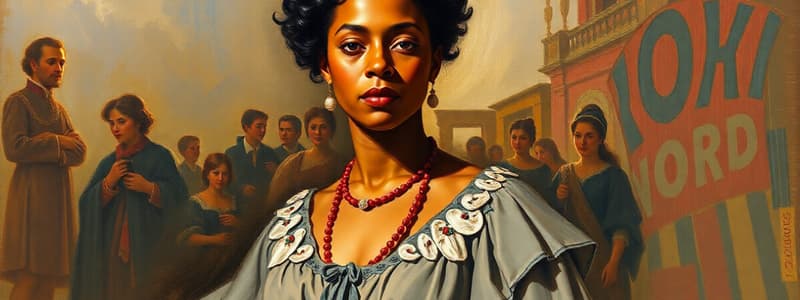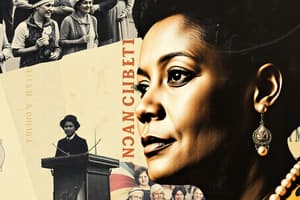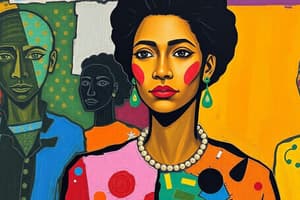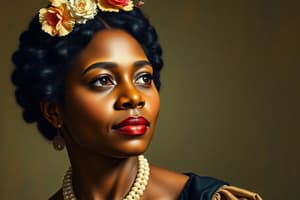Podcast
Questions and Answers
What was Mary Church's early experience with racism?
What was Mary Church's early experience with racism?
- She was prevented from attending President Garfield's inaugural ball because she was Black.
- She was bullied by white girls who ridiculed her for her skin color. (correct)
- She was denied access to a boarding school because of her race.
- She was forced to stop teaching because of racist policies against Black teachers.
What was unusual about Mary Church's background for an African American girl in the South?
What was unusual about Mary Church's background for an African American girl in the South?
- She traveled to Europe for an extended period of time, which was a rare luxury for Black people in the 19th century.
- She had a very wealthy father who owned real estate and a tavern. (correct)
- She had a marriage proposal from a German baron, which was a testament to her social status and education.
- She attended Oberlin College, which was a prestigious institution for Black women at the time.
What did Mary Church believe was the key to improving the lives of African Americans?
What did Mary Church believe was the key to improving the lives of African Americans?
- Economic empowerment through entrepreneurship and business ownership.
- Political activism and lobbying for legislation to protect civil rights.
- Integration and desegregation of educational institutions and public spaces.
- Education and hard work as a means to achieve social and economic progress. (correct)
What was Mary Church's primary motivation for dedicating herself to reform causes?
What was Mary Church's primary motivation for dedicating herself to reform causes?
Which statement best describes the contradiction Mary Church faced in her life?
Which statement best describes the contradiction Mary Church faced in her life?
Why did Mary Church become active in social reform after her marriage?
Why did Mary Church become active in social reform after her marriage?
Which of the following contributed to Mary Church's father's wealth?
Which of the following contributed to Mary Church's father's wealth?
What was the significance of Mary attending President James Garfield's inaugural ball in 1881?
What was the significance of Mary attending President James Garfield's inaugural ball in 1881?
Which organization was NOT founded by Mary Terrell?
Which organization was NOT founded by Mary Terrell?
What was one of the major barriers Mary Terrell faced in her suffrage efforts?
What was one of the major barriers Mary Terrell faced in her suffrage efforts?
Who did Mary Terrell meet in 1898 that significantly influenced her suffrage activism?
Who did Mary Terrell meet in 1898 that significantly influenced her suffrage activism?
In which decade did Mary Terrell lead protests against department store restaurants that barred African Americans?
In which decade did Mary Terrell lead protests against department store restaurants that barred African Americans?
What phrase did Mary Terrell use to express her commitment to uplift her community?
What phrase did Mary Terrell use to express her commitment to uplift her community?
How did Mary Terrell contribute to the interaction between black and white suffragists?
How did Mary Terrell contribute to the interaction between black and white suffragists?
What was Mary Terrell's view on the definition of 'people' in the context of suffrage?
What was Mary Terrell's view on the definition of 'people' in the context of suffrage?
Which statement best reflects Mary Terrell's experiences during her activism?
Which statement best reflects Mary Terrell's experiences during her activism?
What is the main point that Mary Church Terrell is making in the phrase, "When the WORLD takes a step forward in progress, some OLD custo falls Dead at OUR feet"?
What is the main point that Mary Church Terrell is making in the phrase, "When the WORLD takes a step forward in progress, some OLD custo falls Dead at OUR feet"?
How does the movement for women's suffrage become more inclusive according to the passage?
How does the movement for women's suffrage become more inclusive according to the passage?
Why was Harriot Stanton Blatch so interested in the rights of working women?
Why was Harriot Stanton Blatch so interested in the rights of working women?
The quotation at the beginning of the passage, "Seeking no favors because of our color...", suggests what about the suffrage movement?
The quotation at the beginning of the passage, "Seeking no favors because of our color...", suggests what about the suffrage movement?
Based on the content, what can you infer about the role of African American women in the suffrage movement?
Based on the content, what can you infer about the role of African American women in the suffrage movement?
What strategy for furthering the suffrage movement is suggested by the statement "It gradually borne in upon us that the enthusiasm in the suffrage movement in the future would come from the industrial women"?
What strategy for furthering the suffrage movement is suggested by the statement "It gradually borne in upon us that the enthusiasm in the suffrage movement in the future would come from the industrial women"?
The image of Mary Church Terrell is presented as a collage, what is a possible reason for this?
The image of Mary Church Terrell is presented as a collage, what is a possible reason for this?
What is the main conflict described in the passage?
What is the main conflict described in the passage?
Flashcards
Mary Church Terrell's Background
Mary Church Terrell's Background
Mary Church Terrell was born in 1863 into a privileged background, her parents escaping slavery and achieving financial success. She received a top-notch education, attended private schools and graduated from Oberlin College, one of the first African American women to do so.
The Turning Point for Mary Church Terrell
The Turning Point for Mary Church Terrell
Mary Church Terrell's childhood was marked by an incident at boarding school where she was ridiculed for her skin color. This experience ignited her lifelong commitment to fighting racial injustice and advocating for equality.
Mary's Father and his Wealth
Mary's Father and his Wealth
Mary Church Terrell's father, a former slave, amassed wealth in Memphis through savvy real estate purchases, particularly profiting from properties abandoned during yellow fever outbreaks.
Mary's Mother and her Business
Mary's Mother and her Business
Signup and view all the flashcards
Mary's Marriage to Robert Terrell
Mary's Marriage to Robert Terrell
Signup and view all the flashcards
Mary's 'Lifting as We Climb' Philosophy
Mary's 'Lifting as We Climb' Philosophy
Signup and view all the flashcards
Mary Church Terrell's Legacy
Mary Church Terrell's Legacy
Signup and view all the flashcards
Mary Church Terrell and Women's Suffrage
Mary Church Terrell and Women's Suffrage
Signup and view all the flashcards
Obstacles in the South
Obstacles in the South
Signup and view all the flashcards
Prejudice in the North
Prejudice in the North
Signup and view all the flashcards
Bridging the Gap in Suffrage
Bridging the Gap in Suffrage
Signup and view all the flashcards
Lifting as We Climb
Lifting as We Climb
Signup and view all the flashcards
Champion of Civil Rights
Champion of Civil Rights
Signup and view all the flashcards
Organizational Impact
Organizational Impact
Signup and view all the flashcards
Progress and Change
Progress and Change
Signup and view all the flashcards
Equal Chance
Equal Chance
Signup and view all the flashcards
Opening Up the Suffrage Movement
Opening Up the Suffrage Movement
Signup and view all the flashcards
Working Women and Suffrage
Working Women and Suffrage
Signup and view all the flashcards
Triangle Shirtwaist Factory Fire
Triangle Shirtwaist Factory Fire
Signup and view all the flashcards
Women's Rights at Work
Women's Rights at Work
Signup and view all the flashcards
African American Leaders in Suffrage
African American Leaders in Suffrage
Signup and view all the flashcards
Study Notes
Mary Church Terrell
- Born September 23, 1863, died July 24, 1954
- Experienced racial discrimination from a young age
- Attended a co-educational boarding school in Ohio, where she noticed the prejudice against African Americans
- Realized she was judged based on her race at age eight
- Felt ridiculed for her skin color
- Her father, the son of a slave and her white owner, became a millionaire
- Her mother owned a hair salon in the South
- Both parents had successful careers
- She attended private schools and Oberlin College—one of the first African American women to do so
- She was a successful educator and activist
- Became involved in various reform organizations aimed at improving the lives of African Americans
- Worked to gain the vote for women and became a leader in the suffrage movement
- Faced racial prejudice and discrimination in the South and North
- Was involved in 29 different groups in a 12-year period
- Worked for better education, jobs, health care, and living conditions
- Helped found organizations for African Americans
- Met Susan B. Anthony in 1898 and worked toward women's suffrage
- Spoke out about the struggles of African American women, highlighting the double discrimination
- Worked tirelessly for African American suffrage and women's rights
- Attended President Garfield's inaugural ball as the guest of Senator Blanche Bruce, the second African American senator
- Had a significant role in the black suffrage movement
- A pioneer in the modern civil rights movement
- Led protests to challenge discrimination in restaurant and other public facilities
- Advocated for equal rights
- Her life demonstrates a commitment to fighting racial discrimination and promoting equality for women and African Americans.
Studying That Suits You
Use AI to generate personalized quizzes and flashcards to suit your learning preferences.




